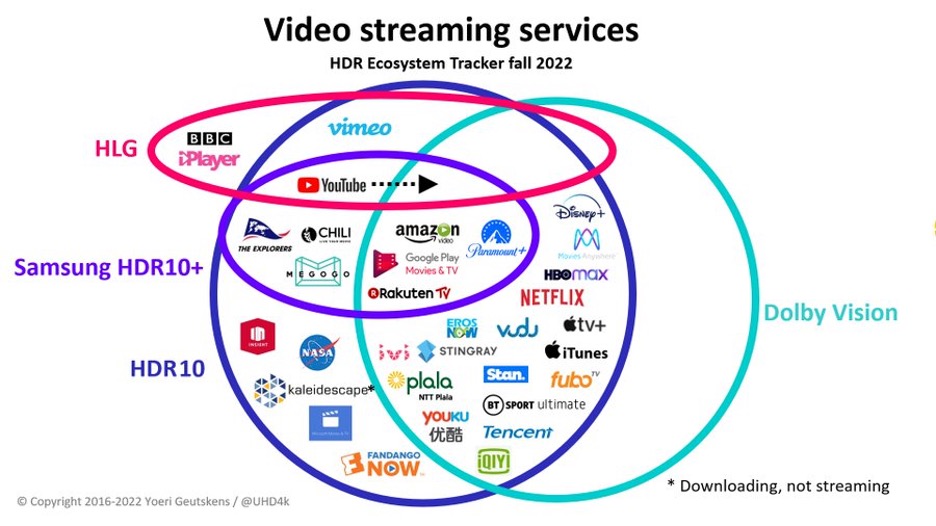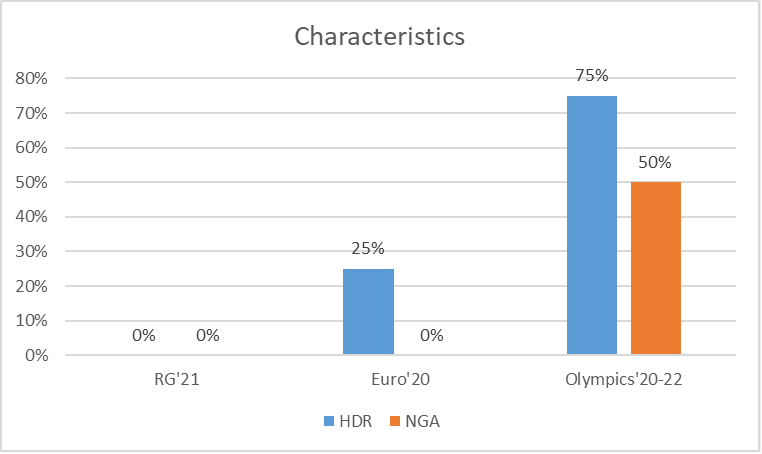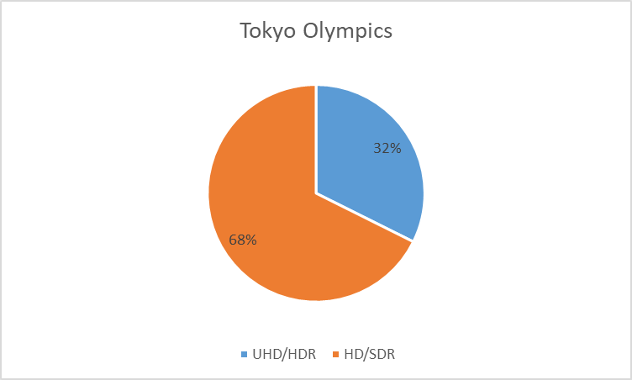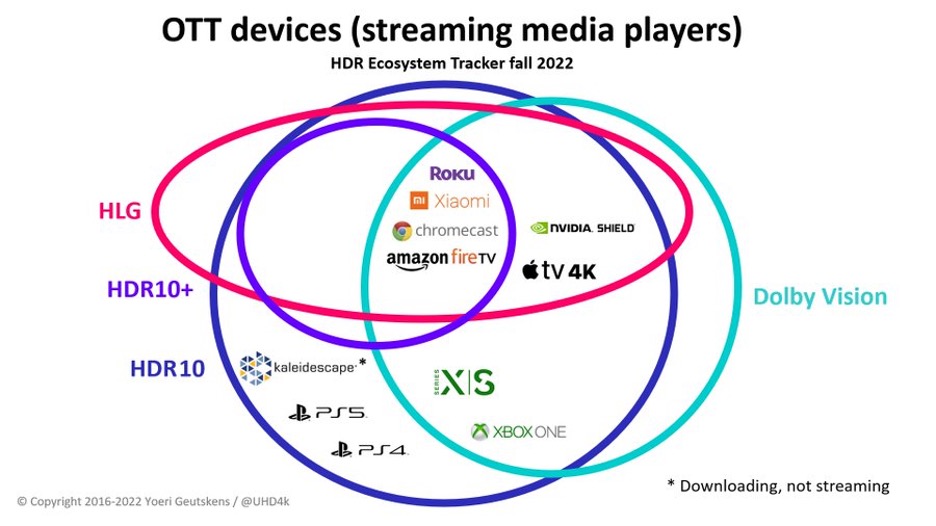By Thierry Fautier, Past President of the Ultra HD Forum, VP Strategy at Harmonic.
I will provide in this blog some personal insights and observations on the Ultra HD OTT market, looking at it from different perspectives: services worldwide, special events, characteristics of production and distribution, devices, interop, and challenges remaining.
Version 3 (major updates since the last version: inclusion of BT Sports)
Introduction
We must always consider two dimensions when talking about Ultra HD services: the number of services and the number of subscribers, which we do for the Ultra HD Forum service tracker [1]. As we only know the number of services for special events but not the associated subscribers, all the numbers I will provide are related to the number of services.
Ultra HD OTT services
The Ultra HD Forum Service Tracker lists 53 Ultra HD OTT services (15 Live and 38 VOD) out of 234 total, a 22% overall share, split into 72% for VOD and 28% for linear.
The @Ultra HD 4K News has recently published a list of UHD OTT services, as summarized in the picture below.

We can count 33 OTT services, smaller than the Ultra HD Forum service tracker.
Major events
OTT is becoming a more and more critical delivery mechanism, as highlighted by these figures I extracted from the Ultra HD Forum’s newsletters on the French tennis open 2021, the Euro 2020 (played in 2021), and the 2020 one (played in 2021) & 2022 Olympics.



Of those three major events, 24% of Ultra HD services were delivered OTT, much higher than the overall market, which was 18% for linear services. Considering that some of the content was also available in catch-up, I got close to the overall Live + VOD percentage of 22%.
Characteristics
I’ll now share a view of the service characteristics in HDR and NGA for the three separate events.

This graph shows a steady increase in the usage of HDR and NGA from none at the 2020 French Open to 75% for HDR and 50% of NGA during the Olympics (2020 & 2022).
Production
Let us now look at production figures for the Tokyo 2020 Olympics and see the share of HDR.

These figures should be compared to 2 sets of data:
Based on this data, the 32% of Ultra HD HDR is very high compared to the VOD and Broadcast ratios.
Devices
Ultra HD OTT is consumed across the following devices:
The Ultra HD Forum has focused on TV and connected devices representing the most significant audience.
While I hesitate to include this in this blog as it will likely be out of date before it is published, I offer this as an informative snapshot in time and encourage the reader to consider how dynamic the Ultra HD marketplace is and the rapid rate of change and new devices. The Ultra HD Forum Guidelines have created a summary table of some major connected TV brands and their associated HDR support.
| Brand | Reference | Support | |
| Sony | https://www.sony.com/electronics/support/articles/00161421 | UHD and HD models support HDR from 2017 onwards | HDR10, HLG, DV |
| LG | https://www.lg.com/us/experience-tvs/hdr/what-is-hdr | All 2017 and later UHD and HD models with HDR also support HDR. | HDR10, HLG, DV, SL-HDR1 |
| Vizio | https://support.vizio.com/s/article/HDR-High-Dynamic-Range?language=en_US | Some 2016 models and all 2017 and later UHD models support HDR. | HDR10, HLG, DV |
| Samsung | https://www.samsung.com/global/tv/blog/what-is-hdr-and-why-is-it-the-future-of-4k-tv/ | Mid-2016 and later, VIZIO SmartCast UHD HDR TVs (P, M, E series) support HLG. | HDR10, HLG, HDR10+ |
| Roku TV (Hisense TCL, sharp, etc.) | https://support.roku.com/article/115007289948-what-is-hdr | All TCL 4K TVs after 2018 support HDR. | HDR10, (some) DV |
| Fire TV | https://www.amazon.com/b/ ?node=8521791011&ref=fs_ods_fs_smp_cp_t2 | Hisense, Toshiba, Amazon, Insignia. | HDR10, DV |
| JVC TV | See link | TV and projectors | HDR10, HLG, DV |
| Panasonic TV | https://www.panasonic.com/uk/consumer/televisions/4K-LED-TV.html | 2016 models support HLG and HDR10m, DV on some models after that date. | HDR10, HLG, DV |
| Philips TV | https://www.usa.philips.com/c-m-so/tv/p/picture-quality | Philips Net, Roku TV, Chromecast TV | HDR10, HLG, DV |
The Ultra HD Forum Guidelines have created a summary table of all the known connected STBs in terms of HDR support.
| Type | Device | HDR Support | Reference | |
| Amazon Fire | FireTV 4K Edition | DV1, HDR10, HDR10+, HLG | https://developer.amazon.com/docs/fire-tv/device-specifications-fire-tv-stick.html?v=ftvstick4k | |
| Fire TV Cube | DV1, HDR10, HLG | https://developer.amazon.com/docs/fire-tv/device-specifications-fire-tv-cube.html?v=ftvcubegen2 | ||
| Android TV | Chromecast w/Google TV Nvidia Shield TV | HDR10, HDR10+, DV HDR10, DV | https://en.wikipedia.org/wiki/Chromecast#Chromecast_with_Google_TV https://en.wikipedia.org/wiki/Nvidia_Shield_TV | |
| Apple TV (2) | Apple 4K | DV1, HDR10, HLG10 , HLG (3) , HDR10+ (4) | https://support.apple.com/en-us/HT208074 | |
| Roku 4K | Roku 4K | DV1, HDR10, HLG10, | https://www.roku.com/products/roku-tv/ picture-quality | |
| Chromecast | Ultra | DV1, HDR10, HLG10 | https://developers.google.com/cast/docs/ media | |
| NVIDIA | Shield | DV1, HDR10, | https://www.nvidia.com/en-us/shield/shield-tv/ | |
| Xiaomi | Mi box | HDR10, | https://www.mi.com/us/mi-box-s/ | |
| PS 4 | HDR10 | https://www.playstation.com/en-us/support/hardware/ps4-how-to-enable-hdr/ | ||
| PS5 | HDR10 | https://www.playstation.com/en-us/support/hardware/ps5-enable-adjust-hdr/ | ||
| Xbox One | HDR10 | https://support.xbox.com/en-US/help/hardware-network/display-sound/hdr-on-xbox-one |
Notes:
- DV= Dolby Vision
(2) As of this publication, Apple TV devices support HLG10 HDR up to 2160p/60
(3) as demonstrated by Canal+ during the Champions League Final 2022
(4) as officially announced at WWDC 2022, and not part of the Forum Guidelines at this stage
The @Ultra HD 4K News has recently published a list of UHD OTT devices (streaming media players), as summarized in the picture below.

This diagram is pretty much aligned with the Ultra HD Forum‘s view.
Interoperability
As I see it, the challenge for an OTT operator who wants to deploy a new service is to adapt the content preparation (encoding, packaging) to the devices’ capability.
The table below provides the different formats supported on the Video and Audio side by each connected device, to the best of my knowledge, at the time of writing this blog. Your feedback on this list and its completeness and accuracy is invited.
| Device | Max Res. | Max Frame rate | HDR | Video Codec | Video Signalling | Audio Codec4 | Packaging | System signalling |
| FireTV 4K Edition | 2160 | 24/59.94 | DV, HDR10, HDR10+ HLG | HEVC | SEI (2) | E-AC-3 w/JoC (Atmos) | HLS/DASH | ISO (3) |
| FireTV Cube | 2160 | 60 | DV HDR10 | HEVC | SEI | E-AC-3 w/JoC (Atmos) | HLS/DASH | ISO |
| FireStick 4K | 2160 | 60 | DV HDR10 | HEVC | SEI | E-AC-3 w/JoC (Atmos) | HLS/DASH | ISO |
| Android TV STB | 2160 | 24/59.94 | HDR10, HLG | HEVC | SEI | HLS/DASH | ISO | |
| AppleTV 4K (1) | 2160 | 24/59.94 | DV HDR10, HLG | HEVC | SEI | E-AC-3 w/JoC (Atmos) | HLS/DASH | ISO |
| Roku 4K | 2160 | 24/59.94 | DV HDR10 HLG | HEVC | SEI | E-AC-3 w/JoC (Atmos) | HLS/DASH | ISO |
| Chromecast Ultra | 2160 | 24/59.94 | DV HDR10, | HEVC | SEI | HLS/DASH | ISO | |
| Nvidia TV Shield | 2160 | 60 | DV HDR10, | HEVC | SEI | E-AC-3 w/JoC (Atmos) | HLS/DASH | ISO |
| Nvidia TV Shield Pro | 2160 | 60 | DV HDR10, | HEVC | SEI | E-AC-3 w/JoC (Atmos) | DASH | ISO |
| Xbox One X | 2160 | 60 | DV HDR10, | HEVC | SEI | E-AC-3 w/JoC (Atmos) | DASH | ISO |
| Xbox One S | 2160 | 60 | DV HDR10, | HEVC | SEI | E-AC-3 w/JoC (Atmos) | DASH | ISO |
| Xiaomi Mi box | 2160 | 60 | HDR10, | HEVC | SEI | HLS/DASH? |
Notes:
- Currently, Apple TV devices support HDR up to 2601p60fps using HLG10.
- HLG requires a VUI message for some backward compatibility modes.
- ISO/IEC 14496-15 – Carriage of network abstraction layer (NAL) unit structured video in the ISO base media file format.
- Audio codecs beyond legacy stereo and multichannel codecs (i.e., AC-3, AAC, HE-AAC, DTS-HD).
The Ultra HD Forum’s charter is to test those as much as possible those combinations during plug fests organized internally, with SDOs, CTA, or with different fora such as DTG (UK) or Deutsch TV Platform.
Ultra HD Devices used in US SVOD services
I provide a list of devices that support different OTT services for consumption on TV, which excludes PCs, Mobiles, and Tablets, based on information provided on the following sites :
This list is not exhaustive and only indicates the depth of integration with various SVOD services in the US. Again, your feedback on this list and its completeness and accuracy is invited.
| Devices | Type | SVOD Services | |||
| Amazon Fire TV | BYOD | HBOmax | Amazon Prime | Netflix | Disney+ |
| Fire TV Cube | BYOD | HBOmax | Amazon Prime | Netflix | Disney+ |
| Android TVs | BYOD | HBOmax | – | – | Disney+ |
| Apple TV 4K | BYOD | HBOmax | Amazon Prime | Netflix | |
| Google Chromecast Ultra | BYOD | HBOmax | Amazon Prime | Netflix | Disney+ |
| Chromecast with Google TV | BYOD | HBOmax | – | – | Disney+ |
| NVIDIA Shield | BYOD | – | Amazon Prime | Netflix | Disney+ |
| Roku Ultra 4800x | BYOD | HBOmax | Amazon Prime | Netflix | Disney+ |
| Roku 4k TVs | BYOD | HBOmax | Amazon Prime | Netflix | Disney+ |
| Roku Premiere | BYOD | HBOmax | Amazon Prime | Netflix | Disney+ |
| Roku Streaming Stick+ | BYOD | HBOmax | Amazon Prime | Netflix | Disney+ |
| Xiaomi Mi Box | BYOD | – | – | – | Disney+ |
| Cox contour 2 | Pay TV | HBOmax | – | Netflix | – |
| Cox stream player | Pay TV | HBOmax | – | Netflix | – |
| Xfinity X1 (Xi6) | Pay TV | HBOmax | – | Netflix | – |
| Xfinity Flex | Pay TV | HBOmax | – | Netflix | – |
| Atlantic | Pay TV | – | – | Netflix | – |
| Blue Ridge | Pay TV | – | – | Netflix | – |
| Cable One | Pay TV | – | – | Netflix | – |
| Dish | Pay TV | – | – | Netflix | – |
| GCI | Pay TV | – | – | Netflix | – |
| Grande | Pay TV | – | – | Netflix | – |
| Mildcontinent | Pay TV | – | – | Netflix | – |
| RCN | Pay TV | – | – | Netflix | – |
| Sudden Link | Pay TV | – | – | Netflix | – |
| Tivo | Pay TV | – | – | Netflix | – |
| Vodafone | Pay TV | – | – | Netflix | – |
| Wave | Pay TV | – | – | Netflix | – |
| Wow | Pay TV | – | – | Netflix | – |
| PlayStation | Game | HBOmax | – | – | – |
| PS VISTA | Game | – | – | Netflix | – |
| PS 3 | Game | – | – | Netflix | – |
| PS 4 | Game | – | – | Netflix | – |
| PS 5 | Game | – | – | Netflix | – |
| Xbox One S | Game | HBOmax | BYOD | Netflix | – |
| Xbox One X | Game | HBOmax | BYOD | Netflix | – |
| Xbox SeriesX|S | Game | HBOmax | – | – | – |
| Xbox X 360 | Game | – | – | Netflix | – |
| Fire TV | cTV | HBOmax | Amazon Prime | Netflix | – |
| Roku TV | cTV | HBOmax | Amazon Prime | Netflix | Disney+ |
| XClass TV | cTV | HBOmax | – | – | – |
| 4K Samsung TV | cTV | HBOmax | Amazon Prime | Netflix | Disney+ |
| LG 4K TV | cTV | HBOmax | Amazon Prime | Netflix | Disney+ |
| Vizio 4K TV | cTV | HBOmax | Amazon Prime | Netflix | – |
| Hisense 4K TV | cTV | – | Amazon Prime | Netflix | – |
| JVC 4K TV | cTV | – | Amazon Prime | – | – |
| Panasonic 4K TV | cTV | – | Amazon Prime | Netflix | – |
| Philips 4K TV | cTV | – | Amazon Prime | Netflix | Disney+ |
| Sharp 4K TV | cTV | – | Amazon Prime | Netflix | Disney+ |
| Sony 4K TV | cTV | HBOmax | Amazon Prime | Netflix | Disney+ |
Out of this table, I can deduce the device penetration metric.
I see Netflix having the highs penetration (86%), followed by HBOmax (49%), Amazon (43%), and Disney+ (35%).
I can extract from this table the common denominator of the 12 devices supporting the four primary SVOD services
| Devices | Type | SVOD Services | |||
| Amazon Fire TV | BYOD | HBOmax | Amazon Prime | Netflix | Disney+ |
| Fire TV Cube | BYOD | HBOmax | Amazon Prime | Netflix | Disney+ |
| Apple TV 4K | BYOD | HBOmax | Amazon Prime | Netflix | |
| Google Chromecast Ultra | BYOD | HBOmax | Amazon Prime | Netflix | Disney+ |
| Roku Ultra 4800x | BYOD | HBOmax | Amazon Prime | Netflix | Disney+ |
| Roku 4k TVs | BYOD | HBOmax | Amazon Prime | Netflix | Disney+ |
| Roku Premiere | BYOD | HBOmax | Amazon Prime | Netflix | Disney+ |
| Roku Streaming Stick+ | BYOD | HBOmax | Amazon Prime | Netflix | Disney+ |
| Roku TV | cTV | HBOmax | Amazon Prime | Netflix | Disney+ |
| 4K Samsung TV | cTV | HBOmax | Amazon Prime | Netflix | Disney+ |
| LG 4K TV | cTV | HBOmax | Amazon Prime | Netflix | Disney+ |
| Sony 4K TV | cTV | HBOmax | Amazon Prime | Netflix | Disney+ |
Ultra HD Devices used in Live services
I provide a list of devices that support different OTT services for consumption on TV, which excludes PCs, Mobiles, and Tablets, based on information provided on the following sites:
- BBC source: https://www.bbc.co.uk/iplayer/help/questions/supported-devices/uhd-supported-devices/
- Amazon Prime (FR ): French tennis open https://www.primevideo.com/help/ref=atv_hp_nd_nav?nodeId=G96EC9QCLFDC95J6
- Fubo TV: https://support.fubo.tv/hc/en-us/articles/360011479911-Does-fuboTV-offer-any-content-in-4K-HDR-
- BT Sports: https://www.bt.com/help/bt-sport/orders-and-upgrade/hdr–high-dynamic-range–with-bt-sport-ultimate
This list is not exhaustive and only indicates the depth of integration with various Live services. Again, your feedback on this list and its completeness and accuracy is invited.
table v3
| Service | Type | BBC | Amazon Prime French Open | Fubo TV | BT Sports |
| Fire TV | BYOD | – | Amazon Prime French Open | FuboTV | – |
| Fire TV Cube | BYOD | – | Amazon Prime French Open | FuboTV | – |
| Apple TV 4K | BYOD | – | – | FuboTV | BT Sports |
| Google Chromecast Ultra | BYOD | – | – | FuboTV | BT Sports |
| Roku 4K | BYOD | BBC | – | FuboTV | – |
| Roku Ultra 4800x | – | – | FuboTV | – | |
| Roku Premiere | – | – | FuboTV | – | |
| Roku Premiere+ | – | – | FuboTV | – | |
| Roku Streaming Stick+ | – | – | FuboTV | – | |
| Xbox One S | – | – | FuboTV | BT Sports | |
| Xbox One X | – | – | FuboTV | BT Sports | |
| Xbox SeriesX|S | – | – | FuboTV | – | |
| Netgem 4K | BYOD | BBC | – | – | – |
| NVIDIA Shield | BYOD | – | Amazon Prime French Open | – | |
| Blu-ray | limited models (1) | – | – | ||
| Android TV STB (NVIDIA Shield, Xiaomi Mi box) | BBC | Amazon Prime French Open | FuboTV | – | |
| Virgin | Pay TV | BBC | – | – | – |
| BT TV Pro | – | BT Sports | |||
| Y ouview | BBC | – | – | – | |
| Android TVs (Hisense, Sharp, Sony, Funai, Sony, TCL) | BBC | – | FuboTV | BT Sports | |
| Roku TV (TCL, Hisense) | cTV | BBC | – | FuboTV | – |
| 4K Samsung TV | cTV | BBC | Amazon Prime French Open | FuboTV | BT Sports |
| LG 4K TV | cTV | BBC | Amazon Prime French Open | FuboTV | BT Sports |
| Vizio 4K TV | – | FuboTV | – | ||
| CVTE | cTV | BBC | – | – | – |
| Difihome | cTV | BBC | – | – | – |
| JVC | cTV | BBC | – | – | – |
| Loewe | cTV | BBC | – | – | – |
| Manahatan | cTV | BBC | – | – | – |
| Panasonic | cTV | BBC | – | – | – |
| Philips | cTV | BBC | – | – | BT Sports |
| Sharp | cTV | BBC | – | – | BT Sports |
| Shenzhen | cTV | BBC | – | – | – |
| Toshiba | cTV | BBC | – | – | BT Sports |
| V estel | cTV | BBC | – | – | – |
| Walker | cTV | BBC | – |
(1) See limitations in https://www.amazon.com/gp/help/customer/display.html?nodeId=GNF8H853SMHNED6Z
Out of this table, I can deduce the device penetration metric.

If we look at all the devices supported, BBC iPlayer has the highest device penetration with 77%, followed closely by FuboTV at 71%, BT Sports at 40%, and Amazon Prime last at 29%.
I can extract from this table the common denominator of the 2 device categories supporting the four major Live services.
| Devices | Type | services | |||
| BBC iPlayer | Amazon Prime French Open | FuboTV | BT Sports | ||
| 4K Samsung TV | cTV | BBC | Amazon Prime | FuboTV | BT Sports |
| LG 4K TV | cTV | BBC | Amazon Prime | FuboTV | BT Sports |
Conclusion
Ultra HD OTT is getting more and more traction initially for VOD, now moving to linear channels and significant events (French Tennis Open, Olympics, Euro, FIFA world cup, Superbowl). The production ratio for significant events in Ultra HD is higher than for TV and VOD. We see a steady increase in the use of HDR and NGA for Ultra HD services. The critical aspect to understand moving forward is device interoperability, and the Ultra HD Forum is working actively on it. If you are part of the Ultra HD OTT value chain and want to test your products, joining the Ultra HD Forum is a great option. We will be happy to help you climb the Ultra HD OTT ladder (no ABR pun intended).
References
[1] https://ultrahdforum.org/uhd-service-tracker/
